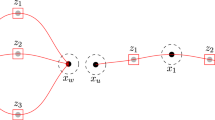Abstract
Asymptotic behaviors are often of particular interest when analyzing Boolean networks that represent biological systems such as signal transduction or gene regulatory networks. Methods based on a generalization of the steady state notion, the so-called trap spaces, can be exploited to investigate attractor properties as well as for model reduction techniques. In this paper, we propose a novel optimization-based method for computing all minimal and maximal trap spaces and motivate their use. In particular, we add a new result yielding a lower bound for the number of cyclic attractors and illustrate the methods with a study of a MAPK pathway model. To test the efficiency and scalability of the method, we compare the performance of the ILP solver gurobi with the ASP solver potassco in a benchmark of random networks.






Similar content being viewed by others
References
Crama Y, Hammer PL (2011) Boolean functions: theory, algorithms, and applications, vol 142. Cambridge University Press, Cambridge
Dubrova E, Teslenko M (2011) A SAT-based algorithm for finding attractors in synchronous boolean networks. IEEE/ACM Trans Comput Biol Bioinform (TCBB) 8(5):1393–1399
Fogelman-Soulie F (1985) Parallel and sequential computation on boolean networks. Theor comput sci 40:275–300
Garg A, Di Cara A, Xenarios I, Mendoza L, De Micheli G (2008) Synchronous versus asynchronous modeling of gene regulatory networks. Bioinform 24(17):1917–1925
Gebser M, Kaminski R, Kaufmann B, Ostrowski M, Schaub T, Schneider M (2011) Potassco: the potsdam answer set solving collection. Ai Commun 24(2):107–124
Gershenson C (2004) Updating schemes in random boolean networks: do they really matter. In: Artificial life IX Proceedings of the 9th international conference on the simulation and synthesis of living systems, MIT Press, pp 238–243
Grieco L, Calzone L, Bernard-Pierrot I, Radvanyi F, Kahn-Perlès B, Thieffry D (2013) Integrative modelling of the influence of mapk network on cancer cell fate decision. PLoS comput Biol 9(10):e1003,286
Gurobi Optimization I (2015) Gurobi optimizer reference manual. www.gurobi.com
Jabbour S, Marques-Silva J, Sais L, Salhi Y (2014) Enumerating prime implicants of propositional formulae in conjunctive normal form. In: Fermé E, Leite J (eds) Logics in artificial intelligence. Springer, pp 152–165
Kauffman SA (1993) The origins of order: self organization and selection in evolution. Oxford University Press, USA
Klarner H (2015) www.sourceforge.net/Projects/BoolNetFixpoints
Klarner H, Bockmayr A, Siebert H (2014) Computing symbolic steady states of boolean networks. In: Was J, Sirakoulis G, Bandini S (eds) Cellular Automata, Lecture Notes in Computer Science, vol 8751, Springer International Publishing, pp 561–570
Müssel C, Hopfensitz M, Kestler HA (2010) Boolnet—an R package for generation, reconstruction, and analysis of boolean networks. Bioinformatics 10:1378–1380
Paulevé L, Chancellor C, Folschette M, Magnin M, Roux O (2014) Analyzing large network dynamics with process hitting. Log Model Biol Syst pp 125–166. doi: 10.1002/9781119005223.ch4
Siebert H (2011) Analysis of discrete bioregulatory networks using symbolic steady states. Bull Math Biol 73:873–898. doi:10.1007/s11538-010-9609-1
Wang RS, Saadatpour A, Albert R (2012) Boolean modeling in systems biology: an overview of methodology and applications. Phys Biol 9(5):055,001
Zañudo JG, Albert R (2013) An effective network reduction approach to find the dynamical repertoire of discrete dynamic networks. Chaos: an interdisciplinary. J Nonlinear Sci 23(2):025–111
Acknowledgments
We thank S. Videla, M. Ostrowski and T. Schaub of University of Potsdam for their help with the ASP formulation.
Author information
Authors and Affiliations
Corresponding author
Additional information
An erratum to this article is available at http://dx.doi.org/10.1007/s11047-016-9611-0.
Rights and permissions
About this article
Cite this article
Klarner, H., Bockmayr, A. & Siebert, H. Computing maximal and minimal trap spaces of Boolean networks. Nat Comput 14, 535–544 (2015). https://doi.org/10.1007/s11047-015-9520-7
Published:
Issue Date:
DOI: https://doi.org/10.1007/s11047-015-9520-7
Keywords
- Boolean networks
- Attractors
- Signal transduction
- Gene regulation
- Answer set programming
- Integer linear programming




